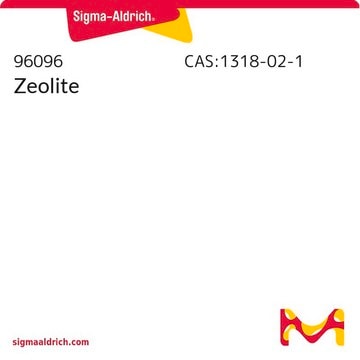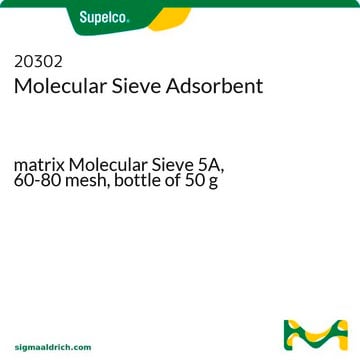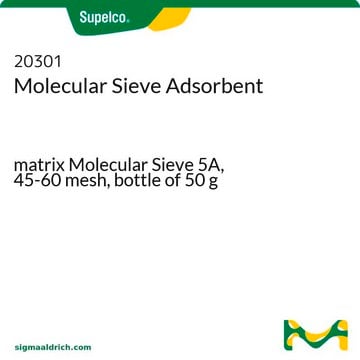208620
Molecular sieves, 5 Å
beads, 8-12 mesh
Iniciar sesiónpara Ver la Fijación de precios por contrato y de la organización
About This Item
Fórmula lineal:
Ca/nNa12-2n[(AlO2)12(SiO2)12] · xH2O
Número de CAS:
MDL number:
UNSPSC Code:
23201100
eCl@ss:
32110204
NACRES:
SB.52
Productos recomendados
form
beads
particle size
8-12 mesh
pore size
5 Å
¿Está buscando productos similares? Visita Guía de comparación de productos
General description
Choosing a Molecular Sieve:
1. The preferential adsorption of one molecule over another depends upon pore diameter and mesh size.
2. The dynamic capacity of the silica gel for adsorbing a particular compound is governed by the internal surface area; the greater the surface area, the greater the dynamic capacity.
3. Rate of adsorption and sharpness of resolution are dependent chiefly on particle size and column packing; a fine particle size gives optimum sharpness of resolution.
4. Liquids are most readily adsorbed from solvents in which they are least soluble; a good solvent makes a good desorbing agent.
5. Highly polar liquids are readily adsorbed. Compounds having hydroxyl groups, or containing oxygen are strongly adsorbed.
6. For similar compounds, the higher the molecular weight the higher the selectivity.
7. For hydrocarbons of similar molecular weight, adsorptivity increases with the number of double bonds.
1. The preferential adsorption of one molecule over another depends upon pore diameter and mesh size.
2. The dynamic capacity of the silica gel for adsorbing a particular compound is governed by the internal surface area; the greater the surface area, the greater the dynamic capacity.
3. Rate of adsorption and sharpness of resolution are dependent chiefly on particle size and column packing; a fine particle size gives optimum sharpness of resolution.
4. Liquids are most readily adsorbed from solvents in which they are least soluble; a good solvent makes a good desorbing agent.
5. Highly polar liquids are readily adsorbed. Compounds having hydroxyl groups, or containing oxygen are strongly adsorbed.
6. For similar compounds, the higher the molecular weight the higher the selectivity.
7. For hydrocarbons of similar molecular weight, adsorptivity increases with the number of double bonds.
Molecular sieves are crystalline metal aluminosilicates having a three-dimensional interconnecting network of silica and alumina tetrahedra. Natural water of hydration is removed from this network by heating to produce uniform cavities which selectively adsorb molecules of a specific size. The 5A form has divalent calcium ions in place of sodium cations give apertures of ~5Å, which exclude molecules of effective diameter >5Å (for example: all 4-carbon rings and iso-compounds). These molecular sieves can adsorb compounds such as n-butane, n-butyl alcohol, propane, docosane and dichlorodifluoro-methane.
Molecular sieves, 5Å are in the form of beads having a particle size in the range of 8-12mesh. Its chemical composition is Ca/nNa12-2n[(AlO2)12(SiO2)12]·xH2O. It is widely employed as an adsorbent. They have been reported to improve the synthesis of structurally diverse α, β-unsaturated esters. Also, they are promising scavengers of small alkynes. They effectively remove 2-butyne by-product formed during alkyne metathesis reactions.
Regeneration or Activation:
A saturated molecular sieve can be restored to its original capacity by regeneration, the principle of which involves changing the conditions surrounding the adsorbent to correspond to a very low equilibrium capacity. In general, the greater the difference between the equilibrium capacities of adsorption and regeneration, the more rapid and complete the regeneration.
The sieve may be regenerated in one of four ways:
1. Thermal reactivation –The maximum regeneration temperature for Silica is 300°C.
2. Pressure reactivation
3. Passing an appropriate fluid through the gel bed at normal temperature and pressure.
4. Displacement of adsorbates by passing a high concentration of molecules in a fluid through the bed.
A saturated molecular sieve can be restored to its original capacity by regeneration, the principle of which involves changing the conditions surrounding the adsorbent to correspond to a very low equilibrium capacity. In general, the greater the difference between the equilibrium capacities of adsorption and regeneration, the more rapid and complete the regeneration.
The sieve may be regenerated in one of four ways:
1. Thermal reactivation –The maximum regeneration temperature for Silica is 300°C.
2. Pressure reactivation
3. Passing an appropriate fluid through the gel bed at normal temperature and pressure.
4. Displacement of adsorbates by passing a high concentration of molecules in a fluid through the bed.
Application
Molecular sieves, 5 Å may be used in the following processes:
- Separation of normal paraffins from branched-chain and cyclic hydrocarbons.
- Removal of hydrogen sulfide, carbon dioxide and mercaptans from natural gas.
Storage Class
11 - Combustible Solids
wgk_germany
WGK 3
flash_point_f
Not applicable
flash_point_c
Not applicable
Certificados de análisis (COA)
Busque Certificados de análisis (COA) introduciendo el número de lote del producto. Los números de lote se encuentran en la etiqueta del producto después de las palabras «Lot» o «Batch»
¿Ya tiene este producto?
Encuentre la documentación para los productos que ha comprado recientemente en la Biblioteca de documentos.
Los clientes también vieron
Multidentate Triphenolsilane-Based Alkyne Metathesis Catalysts.
Yang H, et al.
Advanced Synthesis & Catalysis, 355(5), 885-890 (2013)
Yu-Han Su et al.
Chemical communications (Cambridge, England), 49(58), 6528-6530 (2013-06-14)
A range of terminal alkenes smoothly underwent palladium-catalyzed oxidative alkoxycarbonylation with carbazates under an oxygen atmosphere to afford structurally diverse α,β-unsaturated esters in moderate to good yields with excellent regioselectivity and E selectivity.
Nuestro equipo de científicos tiene experiencia en todas las áreas de investigación: Ciencias de la vida, Ciencia de los materiales, Síntesis química, Cromatografía, Analítica y muchas otras.
Póngase en contacto con el Servicio técnico











